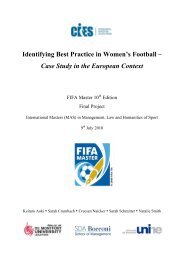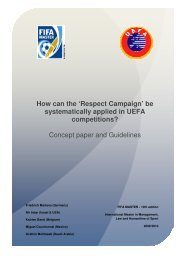Sports Marketing & Sponsorship - FIFA/CIES International University ...
Sports Marketing & Sponsorship - FIFA/CIES International University ...
Sports Marketing & Sponsorship - FIFA/CIES International University ...
- No tags were found...
Create successful ePaper yourself
Turn your PDF publications into a flip-book with our unique Google optimized e-Paper software.
The value of competitionRESEARCH PAPERquality of matches (Baimbridge, 1997) anduncertainty of winning an Olympic medal (Baimbridge,1998). Many studies in the extant literature focus onconsumer characteristics, including the examination ofseveral factors that support the development andmaintenance of fan loyalty. These loyalty factorsinclude fan and team gender (Fink et al, 2002),perceived value (Kim et al, 2007), media (Zhang etal, 1998) and fan identity (Arnett & Laverie, 2000;Laverie & Arnett, 2000).This paper shifts the focus to the fan’s perspective ofproduct value, i.e. what makes a good game. Certainlyfans enjoy seeing their team win, but they also enjoythe excitement of a close game, where the opponentsare evenly matched. If a team consistently performswell relative to its competitors, games are likely to beless suspenseful. In the aggregate, from the leagueperspective, which do fans value more, a consistentlystrong performance by one team or a suspensefulgame? What are the implications for the entireleague’s attendance when the teams are evenlymatched? Overall, does the league’s seasonalattendance increase when one team dominates, orwhen the teams are more evenly balanced?Using a marketing perspective and building on theextant literature (Baade & Tiehen, 1990; Noll, 1974),we investigate these questions by examining the effecton attendance of game outcome doubt, as indicatedby the league’s competitive balance. Through anempirical analysis of longitudinal, archival datagathered from five different sports, this studyinvestigates three categories of factors that might affectattendance: (1) the competitive balance among teamsin the league; (2) the demography of the league’smarkets; and (3) the volatility of the league’smembership.<strong>Marketing</strong> management perspectiveThis section will build on prior research efforts tounderstand sports leagues and their role increating and maintaining a product that has valueto consumers, i.e. an exciting contest. The modelincludes three categories of factors that maypredict fan attendance levels.First, the level of competitiveness among the teamsin the league is posited to be an indication of thevalue of the games anticipated by fans. When teamsare evenly matched, the outcome of the contest isuncertain. This builds suspense and may make theperformance more enjoyable for the fans. One caninfer that matches between more competitive teamswill lead to higher attendance, yielding higherrevenues through ticket sales, sponsorships, licensingagreements and the sale of media rights (Manasso,2008).Second, certain demographic variables inherent inleague markets may influence the likelihood of fanattendance at matches. Specifically, the number ofpeople who live in a given market, their disposableincome and their rate of employment may affectattendance. Consumer marketers use factors such asthese to segment markets and identify the bestsegments to target.Third, deletion of financially weak teams and theaddition of teams in underserved markets may affectattendance. This process is akin to the management ofa portfolio of brands or strategic business units.CompetitivenessA fundamental premise of marketing is that all thingsbeing equal, customers are more likely to buyproducts that offer a higher perceived value. Therefore,attendance would probably be influenced by thequality of the game. One quality that fans value insporting events is suspense, i.e. that the outcome ofthe game should be in doubt because the competitorsare evenly matched. Therefore, the first factorinvestigated is the effect of competitiveness onattendance. We operationalise competitiveness ascompetitive balance, which we define as the degree towhich teams in a league are evenly matched (Baird,2004; Bennett & Fizell, 1995; Quirk & Fort, 1992;Scully, 1989). To determine the competitive balancein the league, competitive imbalance is calculated bycomparing the actual win-loss records of the league tothe theoretical, perfectly balanced league, where every10 <strong>International</strong> Journal of <strong>Sports</strong> <strong>Marketing</strong> & <strong>Sponsorship</strong> ● OCTOBER 2009 ●
















